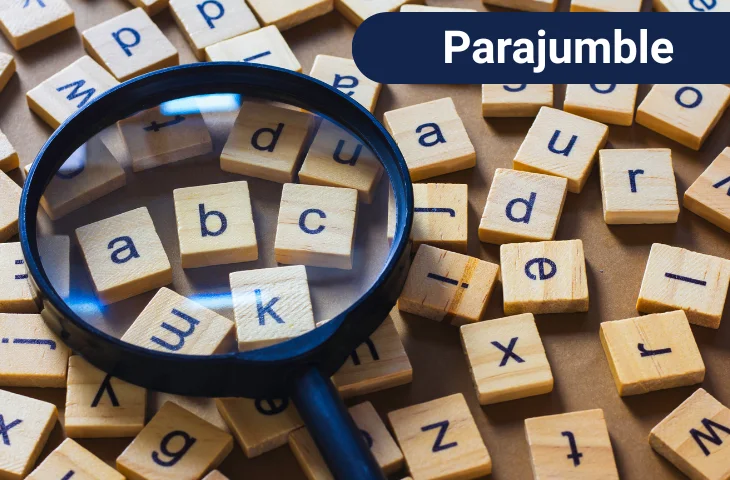Parajumble questions are a common part of English sections in competitive exams like SSC, Banking, and Railways. These questions present a set of sentences in random order, and candidates need to arrange them logically to form a clear and meaningful paragraph.
These questions assess a candidate’s ability to understand sentence flow, logical connections, and overall paragraph coherence. With the right strategy and regular practice, Parajumbles can become one of the highest-scoring topics in English. In this blog, we’ve covered the types of Parajumble questions commonly asked in exams, along with effective strategies, tips, and tricks to solve them with ease.
What Is Parajumble in English?
Parajumble refers to a type of English language question where a set of sentences is given in a jumbled or random order, and the candidate must rearrange them to form a coherent and meaningful paragraph.
Why It Appears in Exams:
Parajumbles test your understanding of sentence flow, logical arrangement, and coherence in paragraph construction — all crucial for strong written and verbal communication.
Skills Required:
- Logical sequencing
- Understanding sentence connectors and transitions
- Identification of opening and concluding sentences
- Visualizing the paragraph as a whole
Why Is Parajumble Important in Competitive Exams?
Parajumble is a common topic from which questions are asked in almost every examination. The details of the number of questions asked from parajumble are as follows:
| Exam | No. of Questions | Difficulty |
| SSC CGL / CHSL | 1–2 | Easy |
| IBPS PO / SBI PO | 1–2 | Moderate |
| RRB NTPC / Group D | 1 | Easy |
| State PSC / Police | 1–2 | Moderate |
How to Start Solving Parajumble Questions?
While solving parajumble questions, aspirants must keep the following points in mind while approaching these questions:
| Term | Explanation |
| Opening Sentence | Usually introduces a person, place, or theme |
| Pronoun Clue | Use of he, she, it, they indicates earlier reference |
| Time Connectors | Words like then, after, finally guide sequence |
| Concluding Sentence | Summarizes or ends the idea logically |
| Transition Words | However, Moreover, Hence give clue to link sentences |
| Chronological Order | If time/event-based, arrange accordingly |
Strategies to Solve Parajumble Questions in English
The strategies to solve parajumble questions are as follows:
| Concept | Explanation |
| Identify the Theme | Read all sentences and figure out the central idea |
| First Sentence Clue | Look for introductions or definitions |
| Pronouns & Articles | Help trace back the subjects |
| Transition Words | Signal sequence or contrast (however, thus, also) |
| Eliminate Odd Pairs | Use logic to remove incompatible sequences |
| Time/Chronology Clue | Events or timeline-based statements help arrange order |
What Are the Types of Parajumble Questions in English?
The types of parajumble questions asked are as follows:
- Basic Sentence Arrangement: 4–6 jumbled sentences to rearrange in correct order
- Static MCQ Format: Select the correct sequence from options
- Blank-Based Parajumbles: Fill the blanks after rearranging
- Odd Sentence Out: Identify one sentence that doesn’t fit
- Connector-Based Questions: Match sentence connectors or concluding statements
Parajumble Formulas for English
While there are no numeric formulas, some of the tricks to approach this questions are as follows:
- [Intro ➝ Elaboration ➝ Example ➝ Conclusion]
- Look for Noun ➝ Then Pronoun
- Use Linkers as Chains: But, So, However help join two ideas
- Time Clues: First, Then, Now, Finally
- Eliminate Option Chains: If A → C is wrong, eliminate sequences with that pair
Parajumble Tricks for SSC CGL and Other Exams
Tricks to solve parajumble questions are as follows:
- Read all sentences quickly to get the gist.
- Identify opening and closing sentences first.
- Look for mandatory pairs (e.g., one sentence defines the other).
- Use transition words to link sentences.
- Pay attention to pronouns and articles.
- Eliminate choices with conflicting logic.
- Always reread your final arrangement for coherence.
- Practice with actual previous year questions.
Solved Parajumble Questions from 2024–25 Exams
Q1. Asked in SSC CGL 2024 Tier 1 Shift 2 – Memory-Based
Sentences:
A. She went out to find her dog.
B. The dog was not in the yard.
C. Finally, she saw it near the gate.
D. She was very worried.
Answer: B → D → A → C
Explanation:
- B introduces the problem
- D shows the emotional response
- A is the action taken
- C is the resolution
Q2. From IBPS PO Prelims 2024 – Memory Based
Sentences:
A. The Prime Minister addressed the nation.
B. He emphasized the importance of vaccination.
C. Citizens were urged to stay cautious.
D. COVID-19 cases had started to rise again.
Answer: D → A → B → C
Explanation:
- D gives context
- A states the action
- B & C follow the speech
Q3. Based on memory – SBI Clerk Mains 2025
Sentences:
A. It is important to save water.
B. Rainwater harvesting is one solution.
C. Water scarcity is rising worldwide.
D. Government should promote sustainable practices.
Answer: C → A → B → D
Parajumble Concepts for Bank Exams
Bank exams like SBI PO and IBPS PO often introduce complex or analytical paragraph jumbles with:
- Close options (confusing transitions)
- Symbol-based direction indicators (rare)
- Slight inference required (e.g., tone of speaker)
Example:
Sentences might be framed with connectors like despite that, on the contrary, in the meantime, requiring deeper logical linking.
Common Mistakes to Avoid while Solving Parajumble
While solving Parajumble English questions, candidates must keep the below mentioned details in mind:
- Choosing sentences with similar openings as the start
- Ignoring connectors and transition words
- Relying on memory-based guesses without logic
- Not checking for coherence in the final paragraph
- Overcomplicating straightforward sentence sequences
What Are Related Topics I Should Revise Next?
Topics you should revise next are as follows:
- Questions Based on Cloze Test
- Rules and Practice Questions for Reading Comprehension
- Various Forms of Active and Passive Voice
- Basic Grammar Rules
FAQs
The most common types include sentence arrangement, identifying the opening/closing sentence, finding the correct sequence, and eliminating the odd sentence out.
Look for sentences that introduce a subject or idea without referring back to something else usually containing names, definitions, or general statements.
Read all sentences, identify links or mandatory pairs, spot connectors (like however, thus, therefore), and eliminate illogical sequences.
Yes, while grammar helps, success in Parajumbles mostly depends on understanding sentence logic, connectors, and paragraph flow.
Words like however, meanwhile, therefore, moreover, and on the other hand help identify relationships between sentences.
- IBPS PO Mains Scorecard 2025 Out Soon, Check and Download Marksheet
- SSC CGL Tier 2 Study Plan 2025 for Last 15 Days Before Exam
- SBI SCO Salary 2025, In Hand Salary, Perks and Allowances
- SBI SCO Syllabus and Exam Pattern 2025, Post-Wise Syllabus
- SBI SCO Recruitment 2025, 996 Posts, Apply Now
- IBPS PO Personality Test 2025 Pattern, Questions, Dates

Hi, I’m Aditi. I work as a Content Writer at Oliveboard, where I have been simplifying exam-related content for the past 4 years. I create clear and easy-to-understand guides for JAIIB, CAIIB, and UGC exams. My work includes breaking down notifications, admit cards, and exam updates, as well as preparing study plans and subject-wise strategies.
My goal is to support working professionals in managing their exam preparation alongside a full-time job and to help them achieve career growth.
